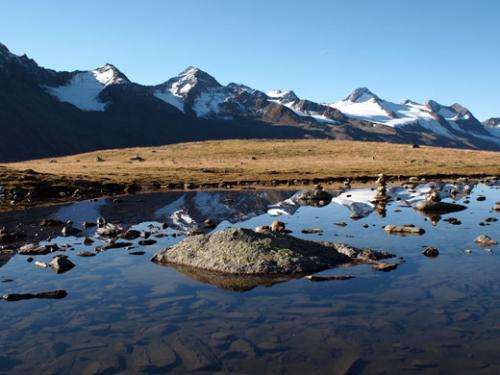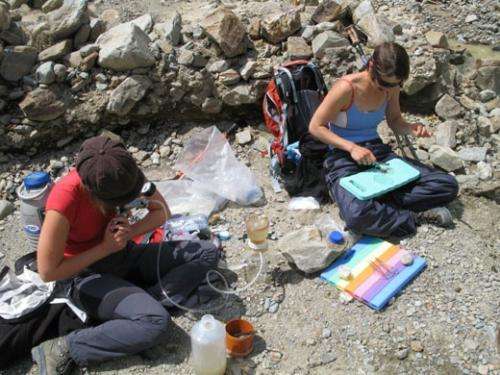Glacial organic matter and carbon cycling

An international collaboration led by Tom Battin from the Department of Limnology of the University of Vienna unravels the role of Alpine glaciers for carbon cycling. The scientists uncover the unexpected biogeochemical complexity of dissolved organic matter locked in glaciers and study its fate for carbon cycling in glacier-fed streams. Their paper, now published in Nature Geoscience, expands current knowledge on the importance of the vanishing cryosphere for biogeochemistry.
Glaciers are receding worldwide with noticeable implications for the hydrological cycle, including sea-level rise. The potential role of glaciers in the carbon cycle remains poorly understood.
An international research team led by Tom J. Battin, Department of Limnology, at the University of Vienna has been able to unravel the biogeochemical complexity of dissolved organic matter in 26 glaciers in the Austrian Alps. Gabriel A. Singer, in collaboration with researchers from Germany (Thorsten Dittmar, Jutta Niggemann), used ultra-high resolution mass spectrometry to identify thousands of organic compounds locked in the glacial ice. Christina Fasching, together with Peter Steier, Faculty of Physics, Vienna Environmental Research Accelerator, estimated the radiocarbon age of the ice-locked organic carbon at several thousand years. She also determined the bioavailability of ice-locked organic carbon for microbial heterotrophs in the glacier-fed streams. For the first time, the researchers were able to relate, at the compound-specific level, radiocarbon age and carbon bioavailability to distinct molecular groups.

The researchers found that the biogeochemistry of the glacier organic matter is unexpectedly diverse. Phenolic compounds derived from vascular plants or soil dominate, together with peptides and lipids, potentially derived from microorganisms dwelling in glacial ice. Combustion products from fossil fuel, in contrast, seem to contribute only marginally to glacial organic matter. A significant fraction of this plant-derived compounds - although several thousand years old - is bioavailable. This finding runs counter to logical perceptions of known relationships between age and bioavailability of organic matter, and highlights glaciers as "freezers" that preserve organic matter as resource to microbial heterotrophs.
Upon release, glacial organic matter may stimulate the heterotrophic metabolism in glacier-fed streams otherwise often devoid of energy sources. Intriguingly, microorganisms in glacier-fed streams may thus respire ancient organic carbon that ultimately leaves the streams as carbon dioxide to the atmosphere. These findings shed new light on the role of mountain glaciers in the carbon cycle.
More information: Biogeochemically diverse organic matter in Alpine glaciers and its downstream fate: Singer, G.A, C. Fasching, L.Wilhelm, J. Niggemann, P. Steier, T. Dittmar & T.J. Battin. Nature Geoscience (2012). DOI: 10.1038/NGEO1581
Journal information: Nature Geoscience
Provided by Universitat Wien
















